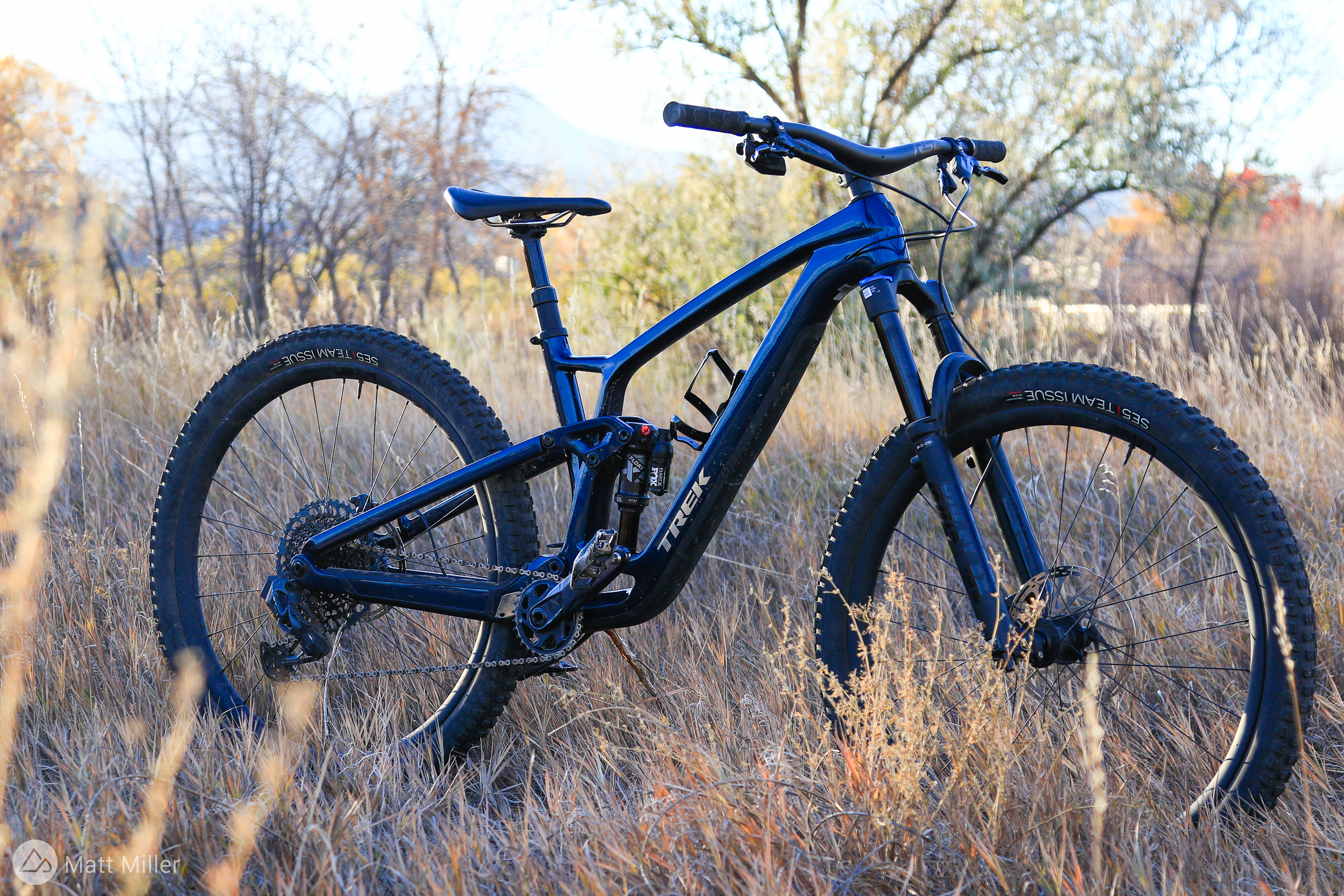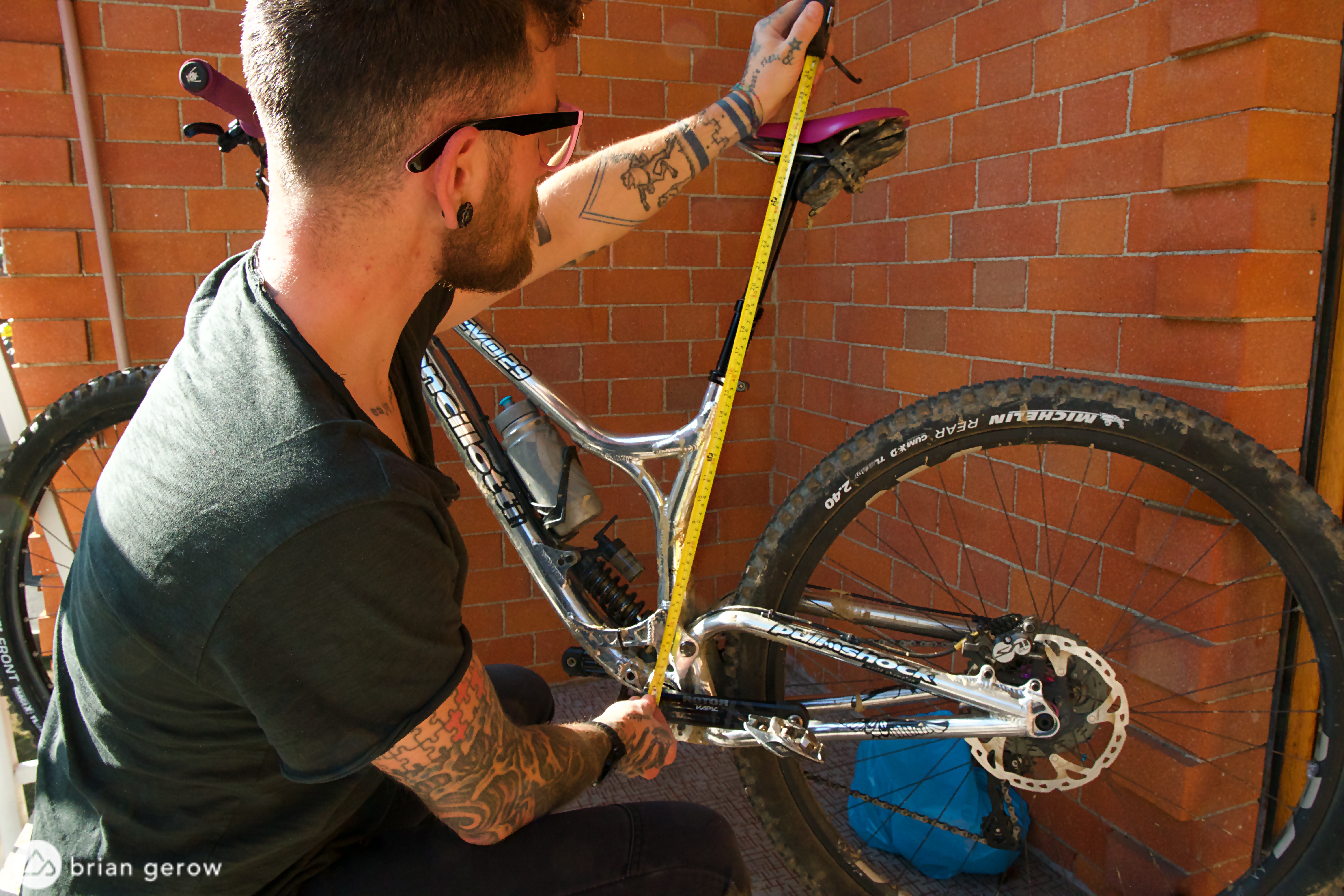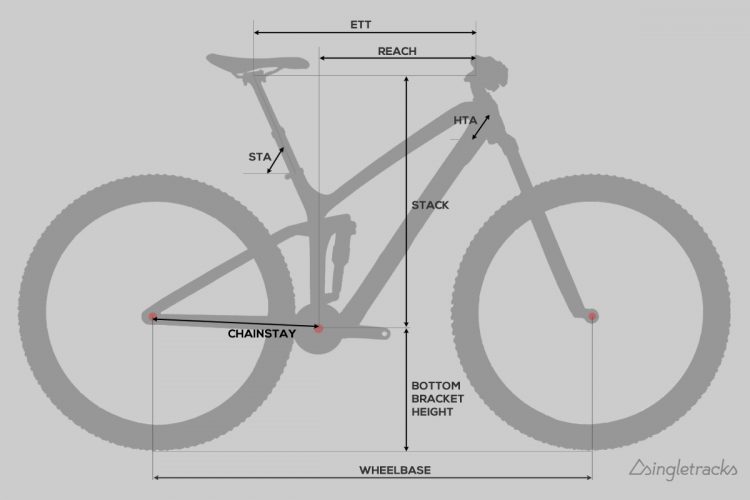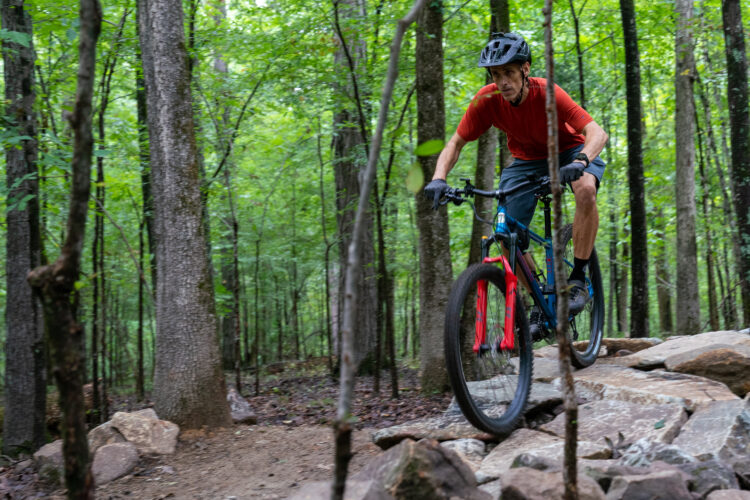
Back in 2016, Singletracks began tracking trail bike geometry. The idea was to look at some of the most popular trail bikes at the time and see how their geometry numbers compared. We then continued to update the data every two or three years to see how geometry changed over time.
Seven years later and knocking on the door of 2024, it seems like a good time to see what’s changed — and what hasn’t — over the past two seasons.
In 2021, the last year we did the comparison, the question surrounding the analysis was whether bikes were getting longer, lower, and slacker (LLS). Back then, the results showed that mountain bikes were continuing to get longer, lower, and slacker.
Is this the Great Plateau?
If longer, lower, and slacker was still the mantra for 2021, is 2023 “The Great Plateau?” Mountain bike media pundits seem to think so.
Last year, Mike Kazimer at Pinkbike wrote an opinion piece on the topic, speculating that geo will continue to change, but not in the drastic leaps we saw over the past decade. And just a few weeks ago, BikeRadar posted a video to their YouTube channel asking if we’ve “reached peak geometry.”
Some are predicting a plateau based on a feeling that the mountain bike industry has already taken geometry progression too far. In January of 2022, the folks at Bikers Edge asked: Is slacker always better? Their conclusion: not always. Worldwide Cyclery discussed the matter on one of their recent podcast episodes. And, of course, riders on forums like MTBR have voiced their opinions.
Opinions about trail bike geometry are one thing. We want to know what the data actually shows.
| Measure | 2016 | 2018 | 2021 | 2023 |
|---|---|---|---|---|
| Front travel | 134.0 | 135.0 | 139.9 | 141.1 |
| Rear travel | 123.0 | 124.7 | 130.6 | 131.0 |
| HTA | 68.0 | 67.3 | 66.0 | 65.7 |
| ETT | 623.0 | 626.9 | 627.8 | 626.2 |
| ESTA | 74.0 | 74.1 | 75.7 | 76.5 |
| Reach | 446.0 | 452.3 | 469.6 | 476.2 |
| Stack | 620.0 | 618.6 | 620.8 | 626.3 |
| Chainstay | 437.0 | 434.2 | 436.7 | 435.9 |
| BB Height | 335.0 | 336.6 | 337.9 | 338.8 |
| Wheelbase | 1176.0 | 1184.3 | 1215.8 | 1226.3 |
2023 Data
So, are bikes getting longer reaches, wheelbases, and chainstays and more suspension, lower bottom brackets, and slacker head tube angles… or are the changes starting to go flat? Well, yes and no.
Like much of the mountain bike media mentioned during the years between this analysis and our last, some aspects of mountain bike geometry have changed drastically, while others have not. Our head tube angles haven’t gotten much slacker in the past two years (about a quarter of a degree), and travel numbers haven’t jumped a ton (both front and rear changed less than a millimeter). Bottom brackets even got a touch higher, and actually have been getting reliably higher since at least 2016.

On the surface, it might seem the “longer, lower, slacker” days are over. But perhaps not. The results from our 2023 data show that while “longer, lower, slacker” may have slowed down, the trend lines are pretty clear, though we are starting to see some convergence among trail bikes that suggests closer agreement on “ideal” numbers.
And while some trail bike geometry changes appear to be moderating, others, such as reach and wheelbase, and even effective seat tube angles, were more drastic.
Reach and wheelbase were the two measurements where trail bikes have seen the most progression. On average, reaches grew by more than 5.5mm from 2021 to 2023, while top tubes shrank by 1.4mm. Wheelbase lengths grew by nearly 9mm despite chainstays shrinking by 0.76mm. In fact chainstay lengths are still shorter than they were in 2016, even though they gained a bit between 2018 and 2021.
A wheelbase growth of 9mm on average is significant. However, we didn’t see consistent growth across all bikes. Instead, this time around a few bikes grew substantially. The reach of the Cannondale Habit grew by 20mm from 2021 to 2023. The GT Sensor and all three Scotts increased their reaches by 10mm. The Rocky Mountain Instinct reach got longer by 27mm, and Niner’s Jet 9 RDO added a massive 34mm to its reach. As you can imagine, those bikes also significantly grew their wheelbases.
While these numbers make it appear that the average trail bike is still getting longer, a significant portion of the change is due to bikes playing catchup. Big changes from just a few bikes obviously affects the average overall.

Yet, even when taking these “outliers” into consideration, bikes still seemed to follow the longer, lower, slacker pattern. Looking at a cross-section of our data to compare HTAs since 2016, the data shows a downward trajectory toward slacker headtubes. Among the select bikes we looked at for the chart above, there does seem to be a flattening of the curve, and some convergence too. In 2016 the range of head tube angles in our sample was about two degrees; today it’s closer to just one degree.

The same happened with reach numbers. Despite the outliers, reach continued to grow on most bikes from 2016 to 2023, effectively making them longer. And like head tube angles, the range of reaches in the sample shrunk from 37mm to less than 15mm.

“Lower” may be the only trend we don’t see continuing. In fact, it was never a trend to begin with, at least with respect to actual bottom bracket heights. A bike’s effective bottom bracket height will vary and depends on the recommended sag. As trail bikes gained travel, the sagged bottom bracket heights likely did indeed go lower. Bottom bracket height is the one area where we found measurements have diverged among our test sample.

Seat tube angles aren’t included in the LLS acronym, but they’ve always been a big part of the trail bike geometry story. Aside from reach and wheelbase numbers, effective seat tube angles have seen the most dramatic changes from 2016 to 2023, getting steeper by 2.5°. Today’s trail bikes are converging around a range of seat tube angles between 75° and 77°.
In terms of what hasn’t changed much, average chainstay lengths have stayed surprisingly consistent over the past seven years. And while effective top tubes have creeped up a bit, they’ve seen few gains since 2018.

Stack heights don’t get a lot of attention, and while the data shows pretty minor changes over time, average stack heights curiously went down from 2016 to 2018, reverted back, then jumped between 2021 and 2023. This is one area where we are likely seeing an over correction in trail bike geometry, and it might be tied to the pursuit of ever longer reaches, and to a lesser degree, higher bottom brackets.
Beginning several years ago, some riders started sizing up to larger frames to get the longer reach they wanted. Brands were paying attention, and around this time some of them moved away from traditional small, medium, and large sizing to give riders more flexibility. We suspect shorter stack heights were utilized to help fit shorter riders on bikes with longer reaches during this time. But this made fits worse for taller riders, and it appears designers may be going back and focusing on delivering better size-specific fits through higher stack heights on large and extra large bikes. Not only that, a taller stack height improves weight distribution for steep descents, which should be desirable as trail bikes become even more capable descenders.
For more information about how we compiled this data, scroll down to the methodology section below. To calculate the overall 2023 averages we looked at the geometry for 27 different bikes from 16 major bike brands. On the line charts above we included only select models for simplicity.

Longer, lower, and slacker… forever?
At this point, the best we can do is look at the data and make educated guesses.
You may have a brand-new frame, but it is likely the same as the year before. And possibly the year before that, too. As much as we like to think of our new bike as the latest and greatest, product cycles have been getting longer over time, and supply chain issues due to Covid-19 extended cycles even further.
Not only that, manufacturers aren’t on the same production cycles. Not all “V2s” are going to come out at the same time. This can leave some manufacturers seemingly playing catchup with evolving bike trends that are driven by whoever had the most recent update. Push geo forward, fall behind, catch up, repeat.
The handful of bikes that are getting significantly longer aren’t doing so just for the sake of longer geometry but rather to align with where today’s buyers expect size large frames to be. With 2023 reach numbers in the 475-480mm range, bikes like the Cannondale Habit’s jump of 20mm to 480mm isn’t unreasonable. Same with the 10mm jump on the GT Sensor.
Niner’s Jet 9 RDO size large had a reach of just 441mm in 2021. For comparison, a 2023 Rocky Mountain Instinct size small has a reach that’s only 4mm shorter. The Jet 9 RDO now sits at a 475mm reach, landing it comfortably in what we would today consider size large.
Other bikes either grew a hair or maintained their previous reach. The Santa Cruz Hightower jumped up a couple of millimeters in reach. The Stumpjumer and Stumpjumer EVO saw no change, but that’s because those bikes haven’t been updated since 2021.

Then there are the bikes that weren’t even around when we started this analysis in 2016, like the Scor 2030 trail bike, that continue to push the geometry envelope. This is a bike with a head angle that’s a degree slacker than the average and a size large reach that’s longer than all in our sample at 496mm. It’s likely that as the trail bikes on this list are updated, some of the designers will be looking to one-up, or at least match, newcomers like Scor, continuing the cycle for another few years.
So while we haven’t quite hit a plateau where numbers flatten out completely, there does seem to be a less drastic change than what we saw in comparing the 2018 data to 2021. However it’s not obvious what’s driving this. It could be that designers and riders have decided we’ve reached peak geometry. Or perhaps we’ve just seen a slowdown in new bike releases as manufacturers work through supply chain issues that began in 2020 and still have not been fully resolved.
Regardless of what’s driving the change, we, like everyone else, still want to know: Where might things be heading in the future?

The future of trail bike geometry
Customizable geometry may be the next phase of mountain biking. Although not a brand new idea, it is popping up on more bikes, and it’s not just things like head and seat angles that are adjustable today; adjustable reach, chainstay, and wheelbase lengths are a thing too.
At least half a dozen of the bikes we looked at all boasted some sort of customizable geometry. This was usually in the form of an adjustable HTA using headset cups. Several bikes also have a flip chip. The Rocky Mountain Instinct may sit at the top of the adjustability pyramid with nine separate geometry settings.
Size-specific chainstays are another trend mountain bike companies are picking up. Again, six bikes on our list have size-specific chainstays. Three of which—the Instinct, Hightower, and Tallboy—also have adjustable geometry.
In spite of the changes and ups and downs, it seems like trail bike geometry is in a pretty damn good place today overall. And it’ll probably continue to get even better.
Show your Support
Become a Singletracks Pro Supporter today and enjoy benefits like ad-free browsing.
With your support we can provide free worldwide trail information and original content created by our team of independent journalists.
Methodology
Beyond geometry, bikes change. Some grow into 29-inch wheels. Some get a bit more travel. Others are discontinued altogether.
Due to this reality, we made changes to how we collected and coded our data over the years. Back in 2016 and 2018 our data included both 29ers and 27.5″ bikes. As we saw the bike industry trending away from 27.5-inch wheels, we dropped the few remaining 27.5″ bikes from our 2021 and 2023 data.
For consistency’s sake, we again used the measurements and geometry of the size large frames for each bike. When frames had any sort of adjustable geometry, such as a flip chip, we used the average between high and low settings.
Considering this is an analysis of trail bike geometry, one has to wonder what exactly a trail bike is. Labels are tricky. One bike is called “downcountry” by a particular brand, while another with nearly identical geometry calls theirs a “trail bike.” One website’s copy mentioned something like “cross-country coming to the trails.” Isn’t XC already on trails? Are they saying it is an XC bike?
Labels aside, we kept our “trail bikes” within a suspension travel range: between 120mm and 150mm of rear and, at most, 160mm of front travel.





















3 Comments
Nov 14, 2023
Nov 14, 2023
Personally I see having an uninterrupted seat tube, which allows for super long droppers, a more important bike feature currently as the geo seems relatively consistent.
There are some frame designs that need to completely change to accommodate this and I bet we'll see that a bit.
Nov 15, 2023